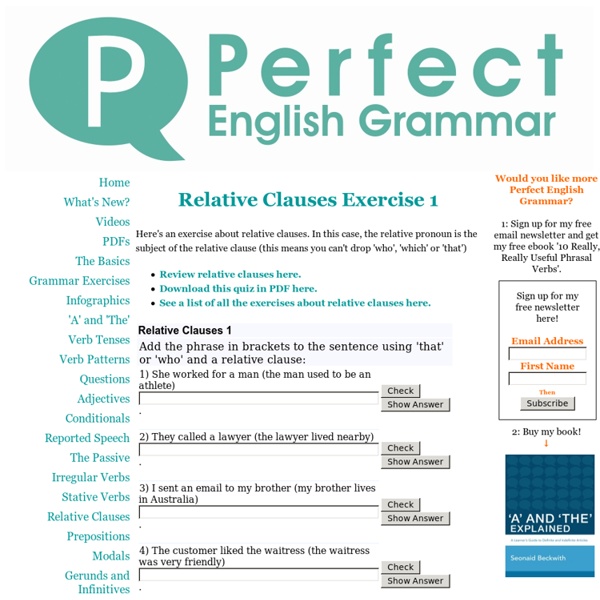



http://www.perfect-english-grammar.com/relative-clauses-exercise-1.html
Related: Test Exercises - all classes! • GramRelative Clauses Content How to form relative clauses Level: lower intermediate Relative pronouns Level: lower intermediate Grammar Instruction with Attitude Grammar Instruction with Attitude Home • Terms • Exercises • MOOC • Handouts • Presentations • Videos • Rules • About • Shop • Feedback ©1997 - 2020 by Robin L. SimmonsAll Rights Reserved. Participle Clauses 1 Reduced Relative Clauses (Download this page in PDF here.) (Click here for information about participle adjectives.) We can use participle clauses after a noun in the same way as relative clauses. This gives more information about the noun.
English page verbes irréguliers Englishpage.com's Irregular Verb Dictionary for English learners contains over 370 irregular verbs used in modern English as well as flashcards and exercises to practice those forms. To view our Extended Irregular Verb Dictionary, which contains over 470 verbs including rare and antiquated forms, Click Here. List of Irregular Verbs Irregular Verb Flashcards and Drills If you want to learn irregular verbs, you need to practice, practice, practice.
Use of English: Tenses Kangaroo injures Australian politician May 18, 2013 A kangaroo (1)(injure) Australian politician Shane Rattenbury in the Australian capital, Canberra, on Thursday. Mr. Rattenbury (2)(take) a morning jog in the Canberra suburb of Ainslie when the kangaroo (3)(surprise) him, and in the ensuing confrontation Mr. Rattenbury (4)(scratch) several times on the leg.By Mr Rattenbury's account, the kangaroo (5)(be) an eastern grey kangaroo, which is a common species in Australia. Upper-intermediate use of English - Exercise 3: Kangaroo injures Australian politician Kangaroo injures Australian politician Saturday, May 18, 2013A kangaroo injured Australian politician Shane Rattenbury in the Australian (1), Canberra, on Thursday. Mr.
Upper-intermediate use of English - Exercise 3 Woman gives birth on New Jersey PATH train Tuesday, January 17, 2012A New Jersey woman, 31-year-old Rabita Sarker, gave birth on a moving Port Authority Trans-Hudson (PATH) train yesterday morning. She and her husband Aditya Saurabh were heading (1) St. Luke's-Roosevelt Hospital in Manhattan (2) a "practice run". She gave birth (3) the Journal Square and 33rd Street stations at 9:49 am ET. Sarker boarded the Manhattan-bound PATH train at Journal Square (4) experiencing labor pains. (5) first she believed these were false, (6) soon realized she was (7) fact giving birth.
Advanced English - Grammar Test 1 She shouldn't have broken that glass. Correct IncorrectBut I did do my homework! Correct IncorrectWhere is the book what I got for my birthday? Low-preparation games to practise present simple questions in English Cristina Cabal, winner of the British Council's TeachingEnglish blog award, has collected her favourite games for practising the tense that isn't always as simple as its name. One of the first things people learn when they study English is the present simple form of verbs. However, learners often forget to add the -s ending to the third person singular: Eva walk to work every day or produce grammatically incorrect questions either by forgetting the auxiliary verb:
Tenses I can't find my dictionary; I wonder whether Mary _____ it now. have had is having hasI'm sorry, I can't talk to you any longer because I _____ dinner. was making make 'm making 've madeWhile everyone else _____, she _____ quietly in the kitchen. laughed - cryed laughed - was cried was laughed - cried was laughing - was cryingThat house is in a terrible state! Useful Expressions to Express Your Opinion in English If it is hard for you to express opinion or yourself in English, these useful expressions can help you a lot. In this lesson you will find frequently used phrases which help you to express yourself; talk about what you think, feel, believe or disagreement easily. By learning this English expressions, you can start new sentences with confident and also improve your writing skills and vocabulary. Writing a successful essay or article is not a problem anymore. Useful Words to Express Your Point of View (Opinion) You can use these expressions to talk about your opinion and point of view.
T053-All tenses - English Grammar Exercises T053-All tenses Gap-fill exercise Fill in all the gaps, then press "Check" to check your answers. Use the "Hint" button to get a free letter if an answer is giving you trouble. You can also click on the "[?]" Tenses and forms-English > BEST RESOURCES: PLACEMENT TEST | GUIDE | OUR BEST WORKSHEETS | Most popular | Contact us > LESSONS AND TESTS: -ing | AS or LIKE | Abbreviations and acronyms... | Adjectives | Adverbs | Agreement/Disagreement | Alphabet | Animals | Articles | Audio test | Be | BE, HAVE, DO, DID, WAS... | Banks, money | Beginners | Betty's adventures | Bilingual dialogues | Business | Buying in a shop | Capital letters | Cars | Celebrations: Thanksgiving, new year... | Clothes | Colours/Colors | Comparisons | Compound words | Conditional and hypothesis | Conjunctions | Contractions | Countries and nationalities | Dates, days, months, seasons | Dictation | Direct/Indirect speech | Diseases | Exclamative sentences! > ABOUT THIS SITE: Copyright Laurent Camus - Learn more / Help / Contact [Terms of use] [Safety tips] | Do not copy or translate - site protected by an international copyright | Cookies | Legal notices. | Our English lessons and tests are 100% free but visitors must pay for Internet access.